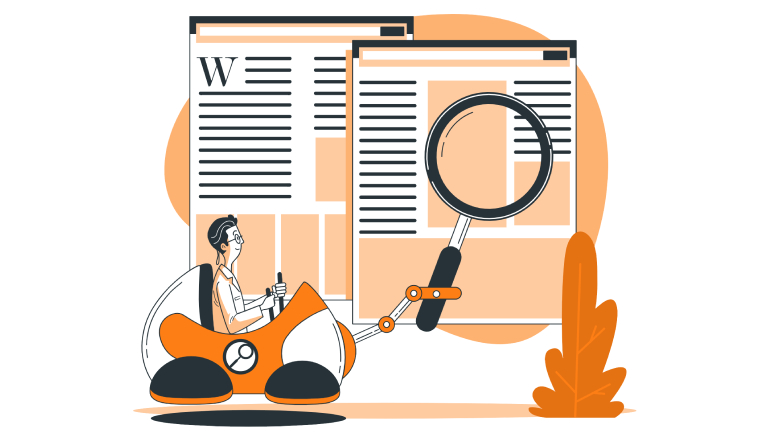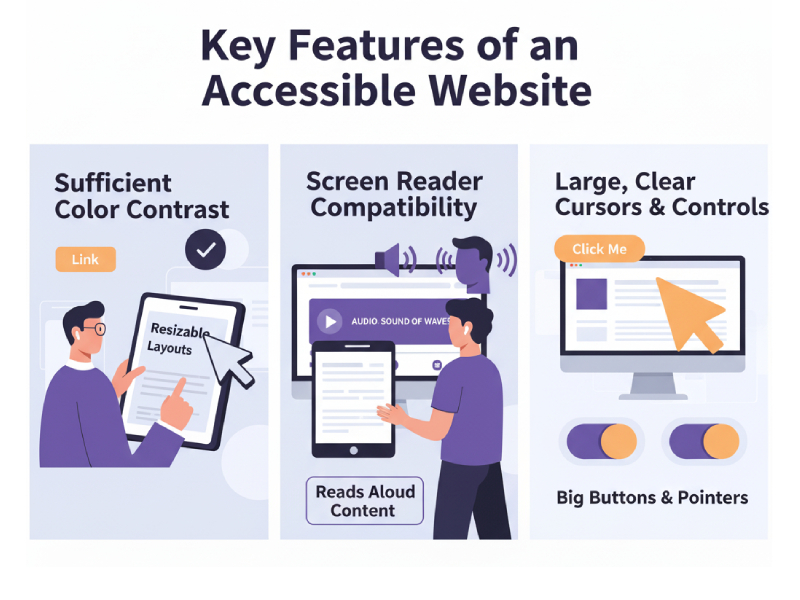
Check Website Accessibility: Manual Checks and Tools to Use in 2025
In today’s digital world, your website serves as the primary gateway for engaging with customers. If your site is not accessible to people with different abilities, you risk losing a significant portion of your audience. Over 20% of Canada’s population has some form of disability, including visual, hearing, motor, or cognitive impairments, and many rely on the internet for shopping and interacting with businesses.
The main goal of website accessibility is to ensure that everyone can use your site smoothly and without barriers. Adhering to these standards is not only a social responsibility but also a business and legal advantage.
BOOST YOUR SEO PERFORMANCE
Smart AI-powered tools to grow your traffic faster
What Is Website Accessibility?
Website accessibility refers to the design and development of web platforms that anyone can use, regardless of their abilities. This includes users with:
- Visual impairments (low vision, blindness, color blindness)
- Hearing loss or auditory limitations
- Mobility challenges, such as difficulty using a mouse
- Cognitive or learning disabilities
- Key features that enhance accessibility include:
- Sufficient color contrast for text, links, and interactive elements
- Resizable text and scalable layouts
- Screen reader compatibility
- Keyboard navigation for users who cannot use a mouse
- Large, clear cursors and interactive controls

Ensuring accessibility is not just ethical; it’s also good business. A more inclusive website attracts more visitors, improves engagement, and demonstrates social responsibility.
If you’re a SEO professional looking to take your strategies to the next level, JetSEO Pro
provides an advanced AI-powered platform designed to optimize content, analyze competitors, and monitor rankings with precision. From automating keyword research to identifying semantic entities and structured data opportunities, JetSEO Pro helps you create content that not only ranks higher on search engines but also aligns with the latest AI-driven SEO trends. With real-time insights and actionable recommendations, it’s an essential tool for any SEO specialist aiming to outperform competitors and maximize organic traffic efficiently.
Key Features of an Accessible Website
follow this sentences:
Sufficient Color Contrast
Good color contrast between text and background ensures readability for users with low vision or color blindness. For example, WCAG recommends a contrast ratio of at least 4.5:1 for normal text and 3:1 for large text. Beyond aesthetics, proper contrast helps all users read content comfortably without eye strain.
Resizable and Legible Text
Users should be able to adjust font size and spacing without breaking the site layout. Flexible typography allows those with visual impairments or reading difficulties to comfortably consume content.
Screen Reader Compatibility
Screen readers interpret text, images, and interactive elements for users who are blind or have severe vision impairments. Providing clear semantic HTML, alt text for images, and properly structured headings enables screen readers to convey meaningful information accurately.
Keyboard Navigation
Not all users can rely on a mouse. Fully accessible websites allow navigation and interaction using a keyboard alone, enabling people with motor disabilities to access forms, menus, and other interactive features. Focus indicators and logical tab order are essential for a smooth keyboard experience.
Accessible Cursors and Controls
Interactive elements like buttons, sliders, and input fields should be large, easily clickable, and clearly identifiable. This benefits users with limited fine motor skills and ensures that all visitors can interact with your website effortlessly.

Why Website Accessibility Matters
An accessible website is not just a legal or ethical obligation; it directly impacts user experience, audience reach, and business outcomes. Accessible design:
- Expands your audience to include people with disabilities.
- Improves SEO, as accessible websites often have clearer structure, alt text, and semantic HTML.
- Reduces legal risk by complying with accessibility standards such as WCAG and Canada’s Accessible Canada Act.
- Enhances overall usability, making the site easier for everyone to navigate.
Types of Website Accessibility Testing
Ensuring your website is accessible isn’t just a technical requirement it’s a commitment to reaching all potential users, including those with disabilities. Accessibility testing is the process of evaluating how well your site accommodates diverse abilities and ensures a smooth experience for everyone. In practice, this testing should focus on multiple user groups, each with unique needs:
In short, accessibility ensures that your website works for everyone visually, cognitively, and physically and positions your brand as inclusive, responsible, and user-focused.
Discovering pages that are not indexed by search engines can be a game-changer for your website’s SEO performance. Our How to Find and Fix Non-Indexed Pages: Step-by-Step Guide walks you through identifying these hidden pages, understanding the reasons behind non-indexing, and implementing actionable fixes such as updating sitemaps, improving internal linking, and resolving crawl errors. Following this guide ensures that all valuable content on your site gets the visibility it deserves, helping you maximize organic traffic and improve overall search rankings.
Users with Visual Impairments
Individuals with low vision, color blindness, or total blindness rely on screen readers, magnification tools, and high-contrast layouts. Testing for this group involves verifying that images have descriptive alternative text, videos include captions or transcripts, and the site’s color palette meets sufficient contrast standards.
Users with Hearing Impairments
People with partial or total hearing loss benefit from captions, transcripts, and visual cues for audio content. Testing should ensure that all multimedia is accompanied by accurate captions, alerts are visually indicated, and video content is fully understandable without sound.
Users with Mobility or Motor Challenges
Some users navigate using keyboards, adaptive switches, or assistive devices. Testing involves confirming that all interactive elements buttons, forms, menus are fully operable without a mouse. This includes checking keyboard tab order, focus indicators, and ensuring drag-and-drop or swipe actions have alternatives.
Users with Cognitive or Learning Disabilities
For people with attention, memory, or processing challenges, clear structure and predictable navigation are essential. Testing for this group means verifying readable text, logical heading hierarchies, consistent layouts, and minimal distractions. Tools like simplified mode toggles and easy-to-understand error messages can enhance accessibility.
Methods of Accessibility Testing
To ensure comprehensive coverage, accessibility testing should combine manual, automated, and user-focused approaches:
- Manual Testing: Designers and developers navigate the site using only keyboard controls or screen readers, noting obstacles and unclear interactions. This method identifies real-world usability issues that automated tools often miss.
- Automated Testing: Tools like WAVE, Axe, or UserWay scan your website to detect common accessibility problems such as missing alt text, poor color contrast, or form labeling issues. These tests are fast, repeatable, and help maintain compliance over time.
- User Testing: Engaging real users with diverse abilities provides invaluable insight. Observing how people with disabilities interact with your website reveals hidden barriers and highlights opportunities for improvement that technology alone cannot uncover.
Why Accessibility Testing Matters
Accessibility isn’t optional it’s a fundamental component of modern website design. In Vancouver’s competitive digital landscape, making your site accessible:
- Expands your audience to include thousands of users who might otherwise be excluded.
- Reduces legal risk by aligning with Canada’s AODA (Accessibility for Ontarians with Disabilities Act) and WCAG standards.
- Improves overall user experience, making navigation and content clearer for all visitors.
- Enhances SEO, as structured, accessible content is easier for search engines to crawl and interpret.
- By combining thoughtful design with robust accessibility testing, organizations can create websites that are inclusive, legally compliant, and optimized for every user. Accessibility becomes not just a compliance task, but a strategic advantage in building trust and engagement across Vancouver and beyond.
Why Website Accessibility Is Essential for Every Organization
In today’s digital-first world, website accessibility is no longer optional it’s a core requirement for businesses aiming to reach all potential customers and avoid costly legal pitfalls. A website that is accessible ensures that everyone, including people with disabilities, can interact with your content, services, and products seamlessly.
Legal Compliance and Risk Management
Canadian accessibility regulations, such as the Accessibility for Ontarians with Disabilities Act (AODA) and the Web Content Accessibility Guidelines (WCAG), set clear standards for websites. These standards ensure that websites are:
- Perceivable content can be accessed and understood through different senses, like sight or hearing.
- Operable users can navigate and interact with your site regardless of their device or ability.
- Understandable content and interface are clear and predictable.
- Robust your site works across different technologies, including assistive tools like screen readers.
Failing to comply can result in legal challenges and damage to your brand’s reputation. In Vancouver, where inclusivity and accessibility are increasingly emphasized, staying compliant demonstrates responsibility and foresight.
Enhancing User Experience
Accessibility is not just about avoiding lawsuits it directly improves the user experience for all visitors:
- Closed Captions & Transcripts: Make videos accessible for users with hearing difficulties and provide alternative ways to consume content in noisy environments.
- Color Contrast & Text Scaling: High contrast and resizable fonts ensure readability for users with low vision or color blindness.
- Keyboard Navigation: Users with mobility limitations can navigate without a mouse, making your site fully operable.
- Alternative Text & Descriptions: Images, charts, and infographics are interpretable by screen readers, enhancing comprehension.
- Text-to-Speech & Assistive Features: Support users who prefer auditory content, benefiting multitaskers and those with cognitive disabilities.
Strategic Business Advantages
Accessible websites create measurable business value:
- Expand Your Reach Over 20% of Canadians have a disability. By designing inclusively, you engage a broader audience.
- Boost SEO & Discoverability Properly structured, accessible content is easier for search engines to index.
- Increase Customer Loyalty Demonstrating inclusivity builds trust, credibility, and brand loyalty.
- Future-proof Your Digital Presence Accessibility standards evolve, and proactive compliance keeps your site ahead of regulatory changes.
Accessibility Is a Competitive Edge
For businesses in Vancouver and beyond, accessibility is not just a compliance checkbox it’s a strategic advantage. By prioritizing inclusive design, organizations remove barriers, foster stronger engagement, and demonstrate a genuine commitment to diversity. Accessible sites benefit everyone, creating a digital experience that’s efficient, enjoyable, and equitable.
In short, investing in website accessibility is an investment in your audience, your reputation, and your long-term growth. It’s a win-win for businesses and users alike.
How to Check Website Accessibility in Vancouver
In today’s digital landscape, your website is the primary gateway to your customers. Ensuring that your site is accessible to all users, including those with disabilities, is not just a legal requirement—it’s a strategic business move. In Canada, over 20% of the population experiences some form of disability, including visual, auditory, motor, and cognitive impairments. Optimizing your website accessibility can expand your audience, improve user experience, and reduce legal risks.
How to Check Website Accessibility in 5 Steps
follow this sentences:
Add Closed Captions for All Videos and Audio Content
Subtitles and transcripts help users with hearing difficulties and improve SEO by making content more discoverable.
Include Alt Text for Images
Alternative text describes the function or content of images for screen readers, providing context to users who cannot see the visuals.
Ensure Color Contrast
High contrast between text and background ensures readability for users with visual impairments or color blindness. Aim for at least 4.5:1 contrast ratio for normal text.
Test Keyboard Navigation
Ensure that all interactive elements can be navigated and activated using a keyboard alone, critical for users with limited mobility.
Use Heading Styles Correctly
Proper hierarchy (H1-H6) helps users understand the structure of content and allows screen readers to navigate your site efficiently.
Checking Compliance with Accessibility Standards
In Canada, websites should follow AODA (Accessibility for Ontarians with Disabilities Act) and WCAG (Web Content Accessibility Guidelines) principles:
- Perceivable All users can perceive the information.
- Operable Everyone can interact with the interface.
- Understandable Information and functionality are easy to comprehend.
- Robust Content works with assistive technologies.
- Failing to meet these standards can result in legal action and reputational damage.
Scientific References for Website Accessibility

Web Accessibility Challenges
This paper explores the main challenges of web accessibility and offers strategies to overcome these barriers. read this pdf: Web Accessibility Challenges
Despite the growing importance of web accessibility, many websites remain inaccessible to significant segments of the population, particularly people with disabilities. This is largely due to the lack of experience among web developers, limited awareness of effective evaluation methods, and insufficient use of accessibility evaluation tools (AEMs).
Conclusion
Ensuring your website is accessible is no longer optional it is a crucial responsibility for any modern business. By designing your site to accommodate users of all abilities, including those with visual, auditory, motor, or cognitive disabilities, you not only comply with legal standards but also expand your potential audience. Accessibility features such as proper color contrast, keyboard navigation, alt text for images, closed captions, and logical heading structures enhance user experience for everyone. Regular testing, both manual and automated, helps identify barriers and continuously improve the site’s usability. Ultimately, an accessible website demonstrates social responsibility, strengthens your brand reputation, and opens your digital doors to a wider, more diverse audience making inclusion a strategic advantage as well as a moral imperative.
FAQ
What does it mean when a page is not indexed?
A non-indexed page is a webpage that search engines like Google haven’t added to their index, meaning it won’t appear in search results. This can happen due to crawl errors, “noindex” tags, or low-quality signals.
How can I identify non-indexed pages on my website?
You can use tools like Google Search Console, Screaming Frog, or Ahrefs to find pages that are not indexed. Checking your sitemap and monitoring crawl reports also helps.
Why are some pages not being indexed even though they are accessible?
Even if a page is accessible, it may be excluded due to duplicate content, thin content, canonical issues, or poor internal linking. Optimizing these aspects improves indexing chances.
What steps should I take to fix non-indexed pages?
Key steps include:
Submitting the page in your sitemap.
Ensuring there’s no “noindex” tag.
Improving internal linking to the page.
Fixing crawl errors and enhancing content quality.